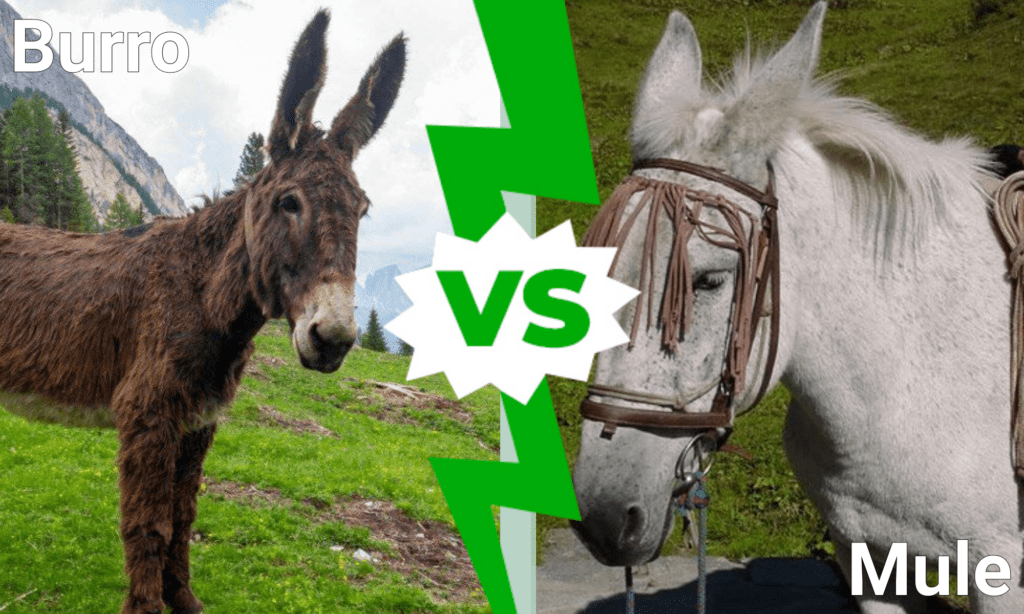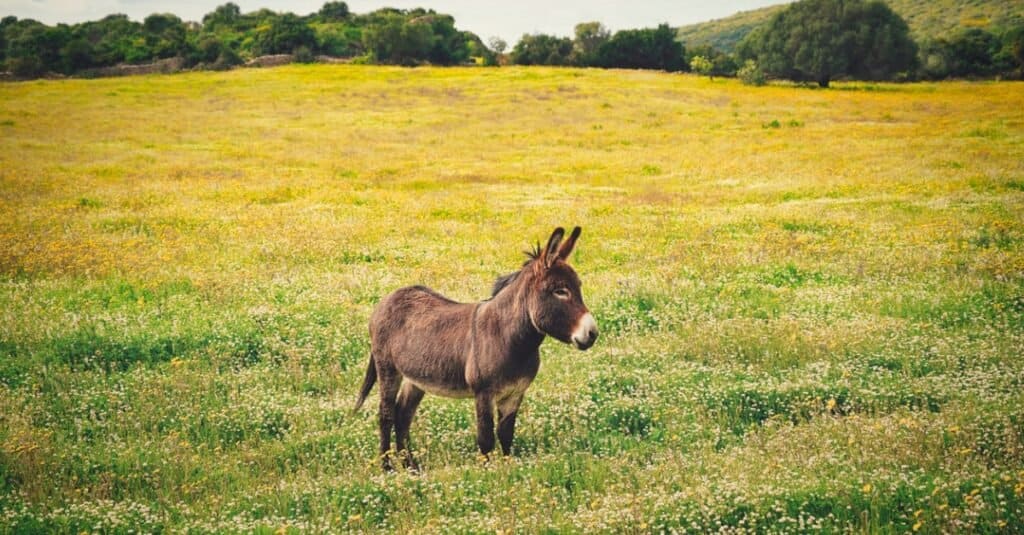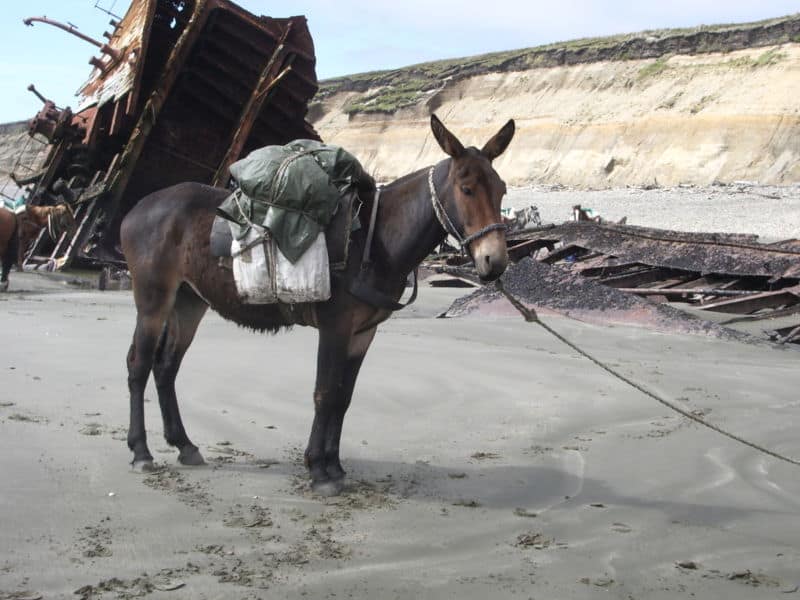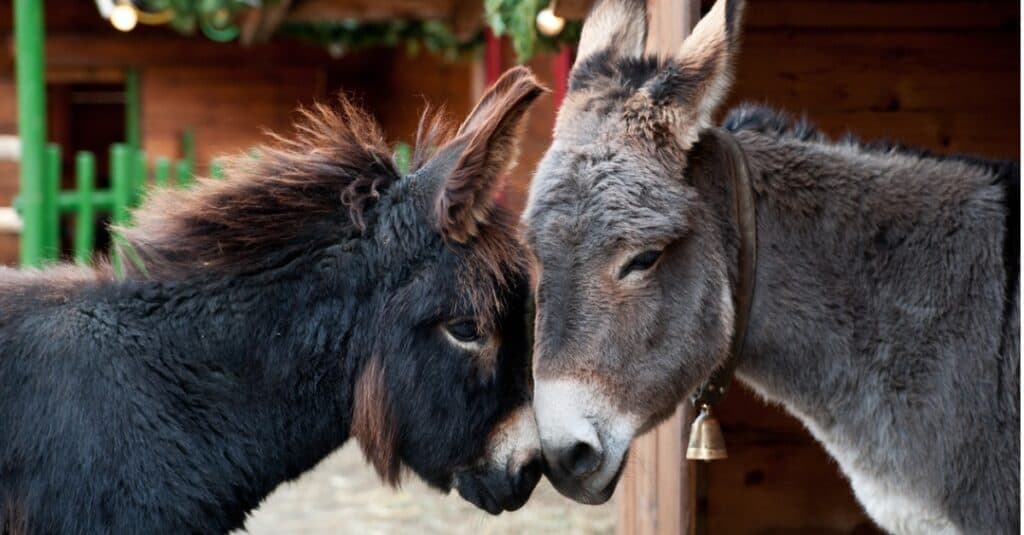Burros and mules are essential pack animals for people around the world. Although they are quite similar in utility, there are distinct differences between the two. Additionally, the various languages with words to refer to these animals add to the confusion as to what they actually are. Today, we are going to learn a bit about both. Let’s discover: Burro vs Mule; what makes them unique?
Comparing a Burro and a Mule

| Burro | Mule | |
|---|---|---|
| Taxonomy | Domesticated Equus africanus (African wild ass). Member of the Equidae family. | Offspring of a male donkey and a female horse. Member of the Equidae family. |
| Size | Height: 25-59 inches at the withers Weight: 180-1,100 lbs | Size varies depending on parents. Height: 50-70 inches Weight: 600-1,500lbs |
| Appearance | Vary in size. Usually brownish, gray, black, and tan. Large ears. | Horselike in appearance. It can come in a variety of colors. Thick head, long ears, and short manes. |
| Distribution | Domestically kept around the world. Feral populations can be found in Australia, South America, North America, and Africa. | Worldwide. |
| Relationship with humans | Domesticated for at least 5,000 years. 96% of donkeys live in underdeveloped countries. Used as pack and draught animals. | Possibly the oldest domesticated animal hybrid. Tougher, coarser, and more patient than a horse but with fewer needs. Often used as a pack animal. |
The 5 main differences between a Burro and a Mule
The main differences between burros and mules are that burros are just domesticated donkeys, are smaller than mules, and are used primarily in underdeveloped countries. Mules are a hybrid of a burro and a horse, are usually larger, and are used as pack animals.
Although it isn’t commonly known to many Americans, a burro is simply a donkey being called by its Spanish name. Simply, all burros are donkeys. There is occasionally differentiation between burros and donkeys in the Rocky Mountains, where feral donkeys are occasionally referred to as burros, although they are still the same species. Mules are a hybrid between a male donkey (jack) and a female horse (mare). The reverse, a female donkey (jenny) and a male horse (stallion), is known as a hinny.
Donkeys (burros) have been around for an extremely long time, likely being domesticated by humans around 5,000 years ago. The wild Equus africanus, otherwise known as the African wild ass, is the living animal that the modern and domesticated donkey originated from. Mules are likely the oldest domesticated hybrid animal and were probably first bred around 3,000 BCE.
Let’s take a closer look at the burro and the mule below to find out what else makes them unique!
Burro vs Mule: Taxonomy

The burro (donkey) is a domesticated animal originating from the African wild ass.
©iStock.com/lo-chef
Burro is simply the Spanish name for the domesticated donkey. Modern domesticated donkeys can trace their origins to the African wild ass, a member of the horse family found in Africa. The African wild ass is critically endangered, although its domesticated cousin can be found worldwide. Both are members of the Equidae family, classifying them closely to horses.
Mules are very closely related to donkeys as the breeding of a mule requires a male donkey. Like the donkey and horse, mules are members of the Equidae family and share half of the genes of a horse and a donkey. Since a mule is a domesticated hybrid that is sterile, it isn’t its own species. Instead, it is regarded and listed as a hybrid species.
Burro vs Mule: Size

Mules generally take after their mothers and are larger than donkeys.
©slowmotiongli/Shutterstock.com
Donkeys are extremely variable in size. Over thousands of years, various regions have created various traits that result in slight variances across the species. On average, a donkey measures 25-59 inches at the withers (the highest point on the back) and can weigh between 180 and 1,100 lbs. In some places, a small donkey is sometimes referred to as a burro.
A mule gets its size from its mother, the mare. With so much variety in horse sizes, mules can be quite variable as well. Most mules stand 50-70 inches at the withers and weigh between 820 and 1000 lbs. A draft mare, for example, will give birth to a larger mule than a quarter horse.
Burro vs Mule: Appearance
The donkey is a well-known animal that most people have seen at least once in their life. It is horse-like in appearance but has long ears, short manes, and stockier builds. Additionally, donkeys are usually brownish or grayish but do come in all sorts of colors in some places.
Mules are more horse-like in their appearance than donkey-like, although they share some of the traits of both. In build, mules are more horse-like but have slightly longer ears, an elongated face, smaller hooves, and thicker skin.
Burro vs Mule: Distribution

Mules can be found all over the world, especially in Asia and Central and South America.
©w:User:Dario u / User:Dario urruty, Public domain, via Wikimedia Commons – License
While both animals can be found all over the world, they do have regions where they are more common. Burros are some of the most efficient pack animals in the world, making them extremely popular in underdeveloped countries. As such, they are found in high numbers in Africa, Central and South America, and Asia.
Mules are extremely useful animals but are larger and require a bit more food and effort to breed than a donkey. As such, they are found in more developed regions. Still, they are found all over the world, especially in China, Mexico, and other South American nations. They are often used in America for tourist work, famously as wagon carriers in places like Charleston, South Carolina.
Burro vs Mule: Relationship with humans

Donkeys have been used as pack animals for thousands of years.
©iStock.com/tepic
Both the donkey and the mule play(ed) an essential role in human society. Donkeys were domesticated first and are used all over the world as a pack and draught animals. Thee are dozens of breeds, all with their unique traits. Since donkeys are adapted to dry, arid regions, they often are used in regions a horse couldn’t survive. Additionally, donkeys are hardier and generally more “stable” than a horse.
Mules were bred to be the perfect middle between a donkey and a horse. Generally, mules are stronger pound for pound than horses, can eat coarser food, have higher endurance than a horse, have a hardier disposition than a horse, and are physically tougher (namely in their skin and hooves). As such, they are often chosen for endurance work and as pack animals.
The photo featured at the top of this post is © BlackDorianstock/Shutterstock.com
Thank you for reading! Have some feedback for us? Contact the AZ Animals editorial team.






